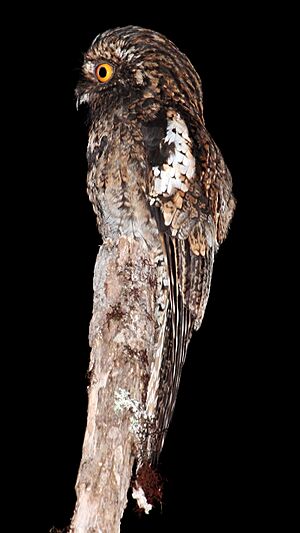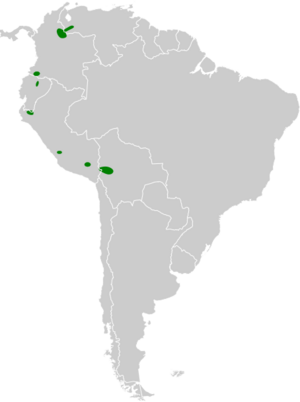Andean potoo facts for kids
Quick facts for kids Andean potoo |
|
|---|---|
 |
|
| Conservation status | |
| Scientific classification | |
| Genus: |
Nyctibius
|
| Species: |
maculosus
|
 |
|
The Andean potoo (Nyctibius maculosus) is a unique type of bird that belongs to the Nyctibiidae family. These birds are known for their amazing camouflage, which helps them blend in with tree branches. You can find them living in parts of Bolivia, Colombia, Ecuador, Peru, and Venezuela.
Contents
About the Andean Potoo
For a while, people thought the Andean potoo was just a different version of the white-winged potoo. But scientists later found out they are separate species. The Andean potoo is different in its size, feather patterns, the sounds it makes, and where it lives in the mountains. It is a one-of-a-kind species, meaning it doesn't have any subspecies.
What Does It Look Like?
The Andean potoo is about 34 to 40.5 centimeters (13 to 16 inches) long. That's roughly the length of a school ruler! A male bird can weigh around 195 grams (6.9 ounces). Females are a bit lighter, weighing between 145 and 185 grams (5.1 to 6.5 ounces).
The male potoo has brown feathers on its back and wings. These feathers have cool patterns of white, buff, and black streaks and spots. Its wing feathers have a broad white stripe that you can see when its wings are closed. The bird's chin and throat are white or grayish. Its chest is brown, and its belly has brown bars and wavy lines.
Female Andean potoos are generally lighter in color. They have more buff or tawny (light brownish-orange) feathers. Their wing stripes are buff instead of white. This helps them blend into their surroundings even better.
Where Do Andean Potoos Live?
Andean potoos live in the Andes mountains. They have been spotted in about a dozen places from western Venezuela down through Colombia, Ecuador, and Peru, all the way to western Bolivia. It's hard to find them because they are so good at hiding. This might make it seem like they live in only a few spots.
These birds usually live at high elevations. You can find them mostly between 1,800 and 2,800 meters (about 5,900 to 9,200 feet) above sea level. They prefer the tops and edges of humid montane forests. These are forests that grow on mountainsides.
Andean Potoo Behavior
How They Find Food
The Andean potoo is a nocturnal bird. This means it is active and hunts for food at night. It catches insects by waiting on a branch and then quickly flying out to grab them in the air. We don't know all the details about what they eat, but insects are a big part of their diet.
Where They Rest During the Day
During the day, the Andean potoo rests or "roosts" on large tree branches. They often pick branches that stick out above the forest canopy. This helps them stay hidden and safe while they sleep.
Breeding Habits
Scientists don't know much about how Andean potoos raise their young. It is thought that they lay a single egg on a tree branch, similar to how other potoos do. The egg is likely laid high up in the forest canopy.
What Sounds Do They Make?
The Andean potoo has a very interesting song. It sounds like a sad, wailing shriek, often described as "kwaaaanh." They repeat this call every 3 to 5 seconds. They also make other sounds, like a slow, hollow "wok wok wok" and a quieter "bu bu bu" call.
Andean Potoo Status
The IUCN (International Union for Conservation of Nature) has listed the Andean potoo as a species of "Least Concern." This means they are not currently in danger of extinction. However, we don't know exactly how many of these birds there are. Their numbers are thought to be going down.
Andean potoos are considered very rare or hard to find. This might be because they are so good at hiding. Losing their forest homes due to deforestation is a possible threat. But these birds can still live in forests where some trees have been cut down.


